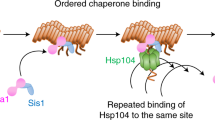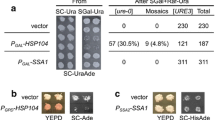Abstract
Chaperones of the diverse ubiquitous Hsp70 family are involved in the regulation of ordered self-perpetuating protein aggregates (amyloids and prions), implicated in both devastating diseases and protein-based inheritance. Yeast ribosome-associated chaperone complex (RAC), composed of the Hsp40 protein Zuo1 and non-canonical Hsp70 protein Ssz1, mediates association of the Hsp70 chaperone Ssb with translating ribosomes. Ssb participates in co-translational protein folding, regulation of premature translation termination, and ribosome biogenesis. The loss of Ssb or disruption of RAC results in the increased formation of [PSI +], a prion form of the translation termination factor Sup35 (eRF3). This implicates co-translational protein misfolding in de novo prion formation. However, RAC disruption also destabilizes pre-existing [PSI +] prions, as Ssb, released from ribosomes to the cytosol in the absence of RAC, antagonizes the function of the major cytosolic chaperone, Ssa, in prion propagation. The mechanism of the Ssa/Ssb antagonism is currently under investigation and may include a competition for substrates and/or co-chaperones. Notably, yeast cells with wild-type RAC also release Ssb to the cytosol in certain unfavorable growth conditions, and Ssb contributes to increased prion loss in these conditions. This indicates that the circulation of Ssb between the ribosome and cytosol may serve as a physiological regulator of the formation and propagation of self-perpetuating protein aggregates. Indeed, RAC and Ssb modulate toxicity of some aggregating proteins in yeast. Mammalian cells lack the Ssb ortholog but contain a RAC counterpart, apparently recruiting other Hsp70 protein(s). Thus, amyloid modulation by ribosome-associated chaperones could be applicable beyond yeast.




Similar content being viewed by others
References
Abrams JL, Verghese J, Gibney PA, Morano KA (2014) Hierarchical functional specificity of cytosolic heat shock protein 70 (Hsp70) nucleotide exchange factors in yeast. J Biol Chem 289:13155–13167. doi:10.1074/jbc.M113.530014
Aguilar-Calvo P, Garcia C, Espinosa JC, Andreoletti O, Torres JM (2015) Prion and prion-like diseases in animals. Virus Res 207:82–93. doi:10.1016/j.virusres.2014.11.026
Albanese V, Reissmann S, Frydman J (2010) A ribosome-anchored chaperone network that facilitates eukaryotic ribosome biogenesis. J Cell Biol 189:69–81. doi:10.1083/jcb.201001054
Ali M, Chernova TA, Newnam GP, Yin L, Shanks J, Karpova TS, Lee A, Laur O, Subramanian S, Kim D, McNally JG, Seyfried NT, Chernoff YO, Wilkinson KD (2014) Stress-dependent proteolytic processing of the actin assembly protein Lsb1 modulates a yeast prion. J Biol Chem 289:27625–27639. doi:10.1074/jbc.M114.582429
Allen KD, Wegrzyn RD, Chernova TA, Muller S, Newnam GP, Winslett PA, Wittich KB, Wilkinson KD, Chernoff YO (2005) Hsp70 chaperones as modulators of prion life cycle: novel effects of Ssa and Ssb on the Saccharomyces cerevisiae prion [PSI +]. Genetics 169:1227–1242. doi:10.1534/genetics.104.037168
Amor AJ, Castanzo DT, Delany SP, Selechnik DM, van Ooy A, Cameron DM (2015) The ribosome-associated complex antagonizes prion formation in yeast. Prion 9:144–164. doi:10.1080/19336896.2015.1022022
Bagriantsev SN, Gracheva EO, Richmond JE, Liebman SW (2008) Variant-specific [PSI +] infection is transmitted by Sup35 polymers within [PSI +] aggregates with heterogeneous protein composition. Mol Biol Cell 19:2433–2443. doi:10.1091/mbc.E08-01-0078
Blanco LP, Evans ML, Smith DR, Badtke MP, Chapman MR (2012) Diversity, biogenesis and function of microbial amyloids. Trends Microbiol 20:66–73. doi:10.1016/j.tim.2011.11.005
Buxbaum JN, Linke RP (2012) A molecular history of the amyloidoses. J Mol Biol 421:142–159. doi:10.1016/j.jmb.2012.01.024
Chacinska A, Szczesniak B, Kochneva-Pervukhova NV, Kushnirov VV, Ter-Avanesyan MD, Boguta M (2001) Ssb1 chaperone is a [PSI +] prion-curing factor. Curr Genet 39:62–67
Chernoff YO, Newnam GP, Kumar J, Allen K, Zink AD (1999) Evidence for a protein mutator in yeast: role of the Hsp70-related chaperone ssb in formation, stability, and toxicity of the [PSI] prion. Mol Cell Biol 19:8103–8112
Chernova TA et al (2011) Prion induction by the short-lived, stress-induced protein Lsb2 is regulated by ubiquitination and association with the actin cytoskeleton. Mol Cell 43:242–252. doi:10.1016/j.molcel.2011.07.001
Chernova TA, Wilkinson KD, Chernoff YO (2014) Physiological and environmental control of yeast prions. FEMS Microbiol Rev 38:326–344. doi:10.1111/1574-6976.12053
Chiabudini M, Conz C, Reckmann F, Rospert S (2012) Ribosome-associated complex and Ssb are required for translational repression induced by polylysine segments within nascent chains. Mol Cell Biol 32:4769–4779. doi:10.1128/MCB.00809-12
Chiabudini M, Tais A, Zhang Y, Hayashi S, Wolfle T, Fitzke E, Rospert S (2014) Release factor eRF3 mediates premature translation termination on polylysine-stalled ribosomes in Saccharomyces cerevisiae. Mol Cell Biol 34:4062–4076. doi:10.1128/MCB.00799-14
Derkatch IL, Bradley ME, Zhou P, Chernoff YO, Liebman SW (1997) Genetic and environmental factors affecting the de novo appearance of the [PSI +] prion in Saccharomyces cerevisiae. Genetics 147:507–519
Derkatch IL, Bradley ME, Hong JY, Liebman SW (2001) Prions affect the appearance of other prions: the story of [PIN +]. Cell 106:171–182
Dragovic Z, Shomura Y, Tzvetkov N, Hartl FU, Bracher A (2006) Fes1p acts as a nucleotide exchange factor for the ribosome-associated molecular chaperone Ssb1p. Biol Chem 387:1593–1600. doi:10.1515/BC.2006.198
Fiaux J, Horst J, Scior A, Preissler S, Koplin A, Bukau B, Deuerling E (2010) Structural analysis of the ribosome-associated complex (RAC) reveals an unusual Hsp70/Hsp40 interaction. J Biol Chem 285:3227–3234. doi:10.1074/jbc.M109.075804
Flynn GC, Chappell TG, Rothman JE (1989) Peptide binding and release by proteins implicated as catalysts of protein assembly. Science 245:385–390
Fowler DM, Koulov AV, Balch WE, Kelly JW (2007) Functional amyloid—from bacteria to humans. Trends Biochem Sci 32:217–224. doi:10.1016/j.tibs.2007.03.003
Gautschi M et al (2001) RAC, a stable ribosome-associated complex in yeast formed by the DnaK-DnaJ homologs Ssz1p and zuotin. Proc Natl Acad Sci USA 98:3762–3767. doi:10.1073/pnas.071057198
Ho YH, Gasch AP (2015) Exploiting the yeast stress-activated signaling network to inform on stress biology and disease signaling. Curr Genet 61:503–511. doi:10.1007/s00294-015-0491-0
Holmes DL, Lancaster AK, Lindquist S, Halfmann R (2013) Heritable remodeling of yeast multicellularity by an environmentally responsive prion. Cell 153:153–165. doi:10.1016/j.cell.2013.02.026
Huang P, Gautschi M, Walter W, Rospert S, Craig EA (2005) The Hsp70 Ssz1 modulates the function of the ribosome-associated J-protein Zuo1. Nat Struct Mol Biol 12:497–504. doi:10.1038/nsmb942
Jaiswal H, Conz C, Otto H, Wolfle T, Fitzke E, Mayer MP, Rospert S (2011) The chaperone network connected to human ribosome-associated complex. Mol Cell Biol 31:1160–1173. doi:10.1128/MCB.00986-10
James P, Pfund C, Craig EA (1997) Functional specificity among Hsp70 molecular chaperones. Science 275:387–389
Kabani M, Melki R (2015a) Sup35p in its soluble and prion states is packaged inside extracellular vesicles. MBio. doi:10.1128/mBio.01017-15
Kabani M, Melki R (2015b) More than just trash bins? Potential roles for extracellular vesicles in the vertical and horizontal transmission of yeast prions. Curr Genet. doi:10.1007/s00294-015-0534-6
Kiktev DA, Melomed MM, Lu CD, Newnam GP, Chernoff YO (2015) Feedback control of prion formation and propagation by the ribosome-associated chaperone complex. Mol Microbiol 96:621–632. doi:10.1111/mmi.12960
Klaips CL, Hochstrasser ML, Langlois CR, Serio TR (2015) Correction: spatial quality control bypasses cell-based limitations on proteostasis to promote prion curing. Elife 4:e06494. doi:10.7554/eLife.06494
Kominek J, Marszalek J, Neuveglise C, Craig EA, Williams BL (2013) The complex evolutionary dynamics of Hsp70s: a genomic and functional perspective. Genome Biol Evol 5:2460–2477. doi:10.1093/gbe/evt192
Koplin A, Preissler S, Ilina Y, Koch M, Scior A, Erhardt M, Deuerling E (2010) A dual function for chaperones SSB-RAC and the NAC nascent polypeptide-associated complex on ribosomes. J Cell Biol 189:57–68. doi:10.1083/jcb.200910074
Kushnirov VV, Kryndushkin DS, Boguta M, Smirnov VN, Ter-Avanesyan MD (2000) Chaperones that cure yeast artificial [PSI +] and their prion-specific effects. Curr Biol 10:1443–1446
Li J, Wu Y, Qian X, Sha B (2006) Crystal structure of yeast Sis1 peptide-binding fragment and Hsp70 Ssa1 C-terminal complex. Biochem J 398:353–360. doi:10.1042/BJ20060618
Liebman SW, Chernoff YO (2012) Prions in yeast. Genetics 191:1041–1072. doi:10.1534/genetics.111.137760
Lopez N, Halladay J, Walter W, Craig EA (1999) SSB, encoding a ribosome-associated chaperone, is coordinately regulated with ribosomal protein genes. J Bacteriol 181:3136–3143
Malinverni D, Marsili S, Barducci A, De Los Rios P (2015) Large-scale conformational transitions and dimerization are encoded in the amino-acid sequences of Hsp70 haperones. PLoS Comput Biol 11:e1004262. doi:10.1371/journal.pcbi.1004262
Nelson RJ, Ziegelhoffer T, Nicolet C, Werner-Washburne M, Craig EA (1992) The translation machinery and 70 kd heat shock protein cooperate in protein synthesis. Cell 71:97–105
Newnam GP, Wegrzyn RD, Lindquist SL, Chernoff YO (1999) Antagonistic interactions between yeast chaperones Hsp104 and Hsp70 in prion curing. Mol Cell Biol 19:1325–1333
Newnam GP, Birchmore JL, Chernoff YO (2011) Destabilization and recovery of a yeast prion after mild heat shock. J Mol Biol 408:432–448. doi:10.1016/j.jmb.2011.02.034
Nizhnikov AA, Antonets KS, Inge-Vechtomov SG, Derkatch IL (2014) Modulation of efficiency of translation termination in Saccharomyces cerevisiae. Prion 8:247–260. doi:10.4161/pri.29851
Osherovich LZ, Weissman JS (2001) Multiple Gln/Asn-rich prion domains confer susceptibility to induction of the yeast [PSI +] prion. Cell 106:183–194
Palleros DR, Welch WJ, Fink AL (1991) Interaction of hsp70 with unfolded proteins: effects of temperature and nucleotides on the kinetics of binding. Proc Natl Acad Sci USA 88:5719–5723
Protacio RU, Storey AJ, Davidson MK, Wahls WP (2015) Nonsense codon suppression in fission yeast due to mutations of tRNA(Ser. 11) and translation release factor Sup35 (eRF3). Curr Genet 61:165–173. doi:10.1007/s00294-014-0465-7
Prunuske AJ, Waltner JK, Kuhn P, Gu B, Craig EA (2012) Role for the molecular chaperones Zuo1 and Ssz1 in quorum sensing via activation of the transcription factor Pdr1. Proc Natl Acad Sci USA 109:472–477. doi:10.1073/pnas.1119184109
Qian X, Hou W, Zhengang L, Sha B (2002) Direct interactions between molecular chaperones heat-shock protein (Hsp) 70 and Hsp40: yeast Hsp70 Ssa1 binds the extreme C-terminal region of yeast Hsp40 Sis1. Biochem J 361:27–34
Reidy M, Masison DC (2011) Modulation and elimination of yeast prions by protein chaperones and co-chaperones. Prion 5:245–249. doi:10.4161/pri.17749
Rikhvanov EG, Romanova NV, Chernoff YO (2007) Chaperone effects on prion and nonprion aggregates. Prion 1:217–222
Sarbeng EB et al (2015) A functional DnaK dimer is essential for the efficient interaction with Hsp40 heat shock protein. J Biol Chem 290:8849–8862. doi:10.1074/jbc.M114.596288
Shaner L, Sousa R, Morano KA (2006) Characterization of Hsp70 binding and nucleotide exchange by the yeast Hsp110 chaperone Sse1. Biochemistry 45:15075–15084. doi:10.1021/bi061279k
Sharma D, Masison DC (2009) Hsp70 structure, function, regulation and influence on yeast prions. Protein Pept Lett 16:571–581
Shorter J, Lindquist S (2008) Hsp104, Hsp70 and Hsp40 interplay regulates formation, growth and elimination of Sup35 prions. EMBO J 27:2712–2724. doi:10.1038/emboj.2008.194
Tyedmers J, Madariaga ML, Lindquist S (2008) Prion switching in response to environmental stress. PLoS Biol 6:e294. doi:10.1371/journal.pbio.0060294
Wallace EW et al (2015) Reversible, specific, active aggregates of endogenous proteins assemble upon heat stress. Cell 162:1286–1298. doi:10.1016/j.cell.2015.08.041
Werner-Washburne M, Craig EA (1989) Expression of members of the Saccharomyces cerevisiae hsp70 multigene family. Genome 31:684–689
Werner-Washburne M, Stone DE, Craig EA (1987) Complex interactions among members of an essential subfamily of hsp70 genes in Saccharomyces cerevisiae. Mol Cell Biol 7:2568–2577
Wickner RB, Shewmaker FP, Bateman DA, Edskes HK, Gorkovskiy A, Dayani Y, Bezsonov EE (2015) Yeast prions: structure, biology, and prion-handling systems. Microbiol Mol Biol Rev 79:1–17. doi:10.1128/MMBR.00041-14
Willmund F et al (2013) The cotranslational function of ribosome-associated Hsp70 in eukaryotic protein homeostasis. Cell 152:196–209. doi:10.1016/j.cell.2012.12.001
Winkler J, Tyedmers J, Bukau B, Mogk A (2012) Hsp70 targets Hsp100 chaperones to substrates for protein disaggregation and prion fragmentation. J Cell Biol 198:387–404. doi:10.1083/jcb.201201074
Zhang Y et al (2014) Structural basis for interaction of a cotranslational chaperone with the eukaryotic ribosome. Nat Struct Mol Biol 21:1042–1046. doi:10.1038/nsmb.2908
Acknowledgments
We thank N. Romanova for help in some experiments, D. Cyr for Sis1 antibodies, E. Craig for the gift of chimeric Hsp70 constructs, P. Chandramowlishwaran and R. Howie for the critical reading of the manuscript. This work was supported by Grant MCB 1516872 from National Science Foundation to YOC. Work on chimeric Hsp70 constructs was also supported by St. Petersburg State University via the Grant 14-50-00069 from Russian Science Foundation.
Author information
Authors and Affiliations
Corresponding author
Additional information
Communicated by M. Kupiec.
Rights and permissions
About this article
Cite this article
Chernoff, Y.O., Kiktev, D.A. Dual role of ribosome-associated chaperones in prion formation and propagation. Curr Genet 62, 677–685 (2016). https://doi.org/10.1007/s00294-016-0586-2
Received:
Revised:
Accepted:
Published:
Issue Date:
DOI: https://doi.org/10.1007/s00294-016-0586-2




